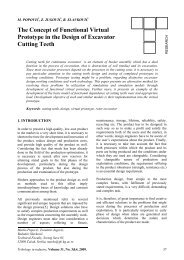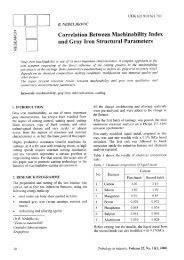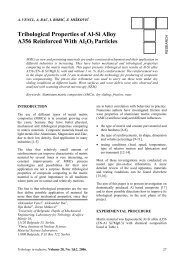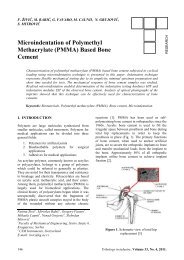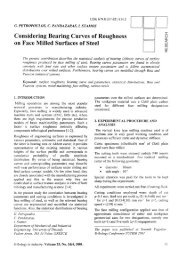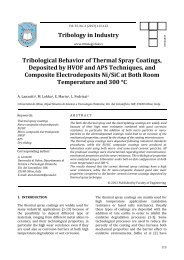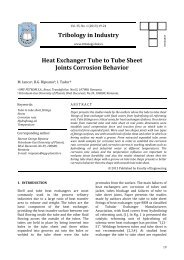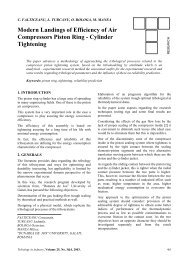a I ;T_r -ra _ _l-.-rx.,'0!.$/d i_ l-^-lt.r-0.rnD/d i | \dw(nca1 ! -- t-- f -o- I -l- . :.; _,;--- -;2-! - - | --t/,---z i ,--' ,----i -t/.--' ,''-/''i 0.1 1l r I. I - -a-t1 r-10a56/l|u1 .;;' 'a'' *d\doa.t I a: l 1i a- I f-"* l-^-u ' lllf Fig. 8. lhr<strong>in</strong>tion of irc nonnal force to the flnnk suiace as a functiott of cutl<strong>in</strong>g paranrctet: a - speed; b - feed; c - depth ofcuu<strong>in</strong>g rioration of the physical cornponents is much weaker. As a result, the fnction force J? <strong>in</strong>creases for 337o,while the normal force F17 is approximately constant ancj so their ratio is situated between 0.15...0.21. The feed's <strong>in</strong>fluence on the friction force F (figure 7b), the normal force Fry (figure Bb) and the ratio between them (figure 9b) is expla<strong>in</strong>ed based on rhe fact that the tear<strong>in</strong>g angle ((p) irtcreases and the longitud<strong>in</strong>al coefficient of plastical cornpression (Cni) decreases as the feeci is higher. When the feed <strong>in</strong>creases frorn 0.1 to 0.-i mn/rot, the friction force,tr and the normal one,l.y <strong>in</strong>crease fronl 25.7 N to 62.1/y' and fron 103.1 N to 351.2 { respecrively. The decreas<strong>in</strong>g tendency of the friction coefficient as the feed <strong>in</strong>creases can be expla<strong>in</strong>ed because of the slower <strong>in</strong>crease of the tangential friction stress on that surface, ascrib<strong>in</strong>q to the normal stress due to thermal effect. The <strong>in</strong>fluence of the cutt<strong>in</strong>g depth on the friction force I (figure 7c), the normal force -[,y (figure 8c) and the ratio betu,een thern (figure 9c) <strong>in</strong> oblique turn<strong>in</strong>g of OLC 45 steel, shows that the values of these components <strong>in</strong>crease clue to thernlal stress, as a result oflclrver snecific prcssitlns on c()ntirct srrrftrcc ,4. Fig. 9. Variation of tltc cutt<strong>in</strong>g specd and the ftictiort coefJicicnt as jitnctiott of cutt<strong>in</strong>g paranrcters: a - spced: l> - fced: c - tleptlt of cuuitrg 5. CONCI,USION The results obta<strong>in</strong>ed us<strong>in</strong>g the methodology proposed above are close enough to those obta<strong>in</strong>ed by other authors <strong>in</strong> their exper<strong>in</strong>rents [4]. The friction force and the friction coefficient on the flank surface of the tool depend on the cutt<strong>in</strong>g pzrrameters. and their values decrease with an average of 251)b for 100-800 rnlrnitt cuttiug speeds, as a result of a rnuch lnore ilttense therntal effect, <strong>in</strong>fluenc<strong>in</strong>g the mechanical chiiracter-istic.s of the material. NOTATIONS: l) - cutt<strong>in</strong>g speed; f ,, n Fa lty Ty, oy Tn, o,z Tt,r,r, (Pd - ship's section; - friction coefficient on the flank surface; - fricrtion coefficient on the rake surface; - tangential, notrr. al stress to the flank surface; - tangeritial. nolllal stress to the rake surface; - maximum tangential stress to rake sur{ace; - base plune; 1A t+ Ii'ibolog, itt itftlustty, \blunre 20, <strong>No</strong>. l, 199g.
(A") - tangent plane to the flank surface, <strong>in</strong> Nl; (,\) - tangent plane to the rake surface, <strong>in</strong> M; (P) - pressure p)ane (normal to the effect. speed) vector i. - the resriltant speed, <strong>in</strong> M; T - tool angles: cutt<strong>in</strong>g edge angle, rake angle, tlank angle, cutt<strong>in</strong>g edge <strong>in</strong>cl<strong>in</strong>ation angle; K,f ,G,,1 - tool angles: cutt<strong>in</strong>g edge angle, rake angle, tlank angle, cutt<strong>in</strong>g edge <strong>in</strong>cl<strong>in</strong>ation angle; Ke,Te, ee,,l.. - work<strong>in</strong>g angles: i,r'ork<strong>in</strong>g cutt<strong>in</strong>g edge angle, rvork<strong>in</strong>g m<strong>in</strong>or cutt<strong>in</strong>g edge <strong>in</strong>cl<strong>in</strong>ation angle; rl - angle bchveen the chip's flow<strong>in</strong>g direction and the vector N, measured <strong>in</strong> (Ay) plane; fu - cutt<strong>in</strong>g force; FD Fv Fz - conponents r.lf the cutt<strong>in</strong>g force along lhe axes of the lvl.ryz si/stem: Fy - plastic deformation force; f,f -tnctr()nforce; Cat - plastic c.leformation coefficient. BIBLIOGRAPHY IT.llrnaratttlei D., ]llodel priv<strong>in</strong>d structura lizica a fotelor dc aschiere la prelucrarea cu viteza mare cu scula cu tais, Analele Univ. 1-fi, Suceavir, 1993, pl.i2-75. 12.)Arnarandei, D., Cozrnittca, N(., Mirotrcasa, C., Relatie de calcul a coeficientului de frecare la aschiere, Analele Universitatii, nr. I-6, Suceava, Sectiunea Mecanica, 1993, p.50-,52. 13.) Amarandei, D., Methodes exper<strong>in</strong>tentales appliquees a la modelisation de I' us<strong>in</strong>age par outil coupant dans le but de la determ<strong>in</strong>ation des forces de deformation plastique et de frottement pendant la coupe a grande viesse, Diplome d'Etudes Approf. de N{ecaniquer, INSA Lyon, Franta, 1993. 14.)Amaratdcr, 1)., Cecetari priv<strong>in</strong>d nrarimea fbtelor de deformare plastica si de fiecare la aschierea cu viteze mari a otelurilor carbon, Teza de doctorat, Universitatea Tehnica "Gh. Asachi" Iasi, mai 1996. [5.] Amartuulei, D..Iixirec<strong>in</strong>rental nrethod applied for modell<strong>in</strong>g edge tool cutt<strong>in</strong>g n'ith aim of evaluation the plastic deformation forces and friction forces at high speed mach<strong>in</strong><strong>in</strong>g, 4-TH Yugoslav Conference of Tribolog, .2i -29 sept. i995, Belgrad. [6.)Andt, G. Ultra - High - Speed I\{ach<strong>in</strong><strong>in</strong>g: A Review and an Analysis of Cutt<strong>in</strong>g F-orces, Proc. Inst. Mech., Eng., 1973, vol. 187, 44173,pa9.625-634. [7.lAndt, d., Ultra-I{igh-Speed l\{ach<strong>in</strong><strong>in</strong>g, Annals of the CIRP, v ol. 2I l l, 19'72. [8.)tltana.riu, N.,l'r'ibologr <strong>in</strong> Fornr<strong>in</strong>g Processes of the rnetallic materials, Tril-.otehnica 87, The-5-th Conferense on friction LLrbrification and Wear, Bucuieti, septenrlriie 1987, p.5-12. 19.) Belous, Z, S<strong>in</strong>teza sculeor aschietoare, Eitura Junimea.Iasi.1980. [10.] Coan<strong>in</strong>ca, M .,llazelc generarii suprafetelor pe mas<strong>in</strong>i unlte, Universitatea Tehnica "Gh: Asachi" Iasi, 1992, p.155-197. lI\.)Desrnortd, F., M., Pr<strong>in</strong>ciples and applications of Tribolog,,, Copyrrght, 197 5, p.254-258. [12.] Elcpitt,l..P. - Scorostnoe rezanie i ego effectihnosti ;rri obrabotke vleakik nraterialov, Sb. Nauki, TR /Gorki, Intlnj.vod Transp., 198B, 233, pag.55-62. 113.1 Erdal, Ii., Elijah, K., A,sibu, - "Ir'. Acoustic emission and Force sensor Fusion fbr monitor<strong>in</strong>g the Cutt<strong>in</strong>g Proces, Int. J. Mech. Voi. 31, <strong>No</strong>. 11/12, pag. 795- 809, 1989. [14.] I<strong>in</strong>ust, Il., trferchortt, NI.Ii., Cltip Forrnation Friction and Higlt Quality l{ach<strong>in</strong><strong>in</strong>g, Surface Treatment of N{etnls, Prepr<strong>in</strong>ts, -53, ASME, 1941. 115,1 Ippolito, R., I-ontittcasa, 5., Elqtitt,.L., Mecanica del taglio ad alta velocita, Ustensil, 3/1985. p.45-51. lI6.)Kravccttko, G.A., O vleanii llararnetrov obrabotki na sili deisvuiosie na zadnei poverhnosti <strong>in</strong>strumenta, Vestnik Mas<strong>in</strong>ostr., fi, 1989, p..11-43. [\7.)Krotrcnberg, M., Machirr<strong>in</strong>g Science, London, 1966 78.) lrlerclmttl, M., Meclranics of the Metal Cutt<strong>in</strong>g I'rocess, Journal of Appliecl Physics, vol. 16, no. 5, 1946, pag.267 -575. [19.] lvblitnt'i, A., Dtulziuki, D. - Stationary shear band <strong>in</strong> high-speed nrach<strong>in</strong><strong>in</strong>g, C.R. Acad. Sci., Paris, 315, Seria II, plg.399-40.5,1992. 120.] Ilt.cht, R..rr., A l)ynrarnic Analysis of High - Speed N{ach<strong>in</strong><strong>in</strong>g. Journal of Eng<strong>in</strong>eer<strong>in</strong>g for <strong>Industry</strong>, <strong>No</strong>vember, I 985, voI.107, pag.309-315. l2l.f Zoret, N..A/., Despre <strong>in</strong>terclepenclenta proceselor d<strong>in</strong> zona fbrnrirrii aschiei si d<strong>in</strong> zona de contact a I'etei de degajare a sulei, Bulet<strong>in</strong>Lrl Construciei de lvlasir-ri, nr. 12, 1963, p.198-207 . [22.] Zorev, NN., .r.a., Razvitie nauki o rezanii rnetallov, Moskva, 1967. Tiibologt, irt itrcltuytni, Volurne 20, <strong>No</strong>. I, <strong>1998</strong>. i.5



